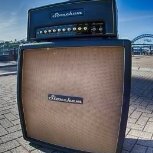Who loves the sound of some outdated electronic glass bottles with killer voltages running through them?
I've been lucky enough to own a few good ones, a few dodgy ones, and I still own a great one.
Worst was a Marshall TSL122. The clean channel was alright, the other 2 channels were dreadful. It was too powerful an amp for the house, even with the Power Reduction switch engaged. Hey ho, you live & learn.
Had a JCM800 2x12 combo for a while. One of the single channel ones. Sounded great, but it had been revalved many moons previously for 5881's, they sounded good, but they didn't last very well, so it had to be revalved regularly at great expense. After I got it, a speaker failed, so I had to get a replacement (Celestion V30), then the other failed, so I stupidly put another V30 in it. Completely ruined it. Sounded awful with 2 V30's, couldn't get it to sound right after that.
The best one, is a Matamp 1224. Hand built in Yorkshire, pure valvey goodness, and with a really nice vinyl finish that they managed to source specifically for me. Got a matching 4x12 cab and a 1x12 cab for home use, both finished in the same vinyl. Had the faceplate replaced after a year with the "block" 70's Matamp logo. The amp has valve switching features where you can choose 4 different power valve combinations, 1 valve in Class A, 2 valves in Class A, 2 valves in Class AB1 & 4 valves in Class AB1. There's also a half power switch and a Pentode/Triode switch on the back.
What have you got???



